You might have heard of ‘The Great Resignation’ - a phenomenon causing workers to quit their jobs. Studies are showing us that employees are feeling the effects of burnout.
With this comes the employee quest for better jobs. Employees want to work for companies who provide a good employee experience.
It’s the cycle of life that certain employees will quit their job as they move on to the next phase of their lives. Have you had a surge of people leaving? Almost like a chain reaction? It might be time to rethink how you retain your employees.
In this blog post we’ll be covering:
- What is Employee Retention?
- Why Do Employees Leave? [Employee Retention Drivers]
- Why Retaining your Employees is so Important
- How to Measure Employee Retention
- What is a Good Employee Retention Rate?
- Reasons for a Poor Employee Retention Rate
- Employee Retention Strategies
- How an Intranet can Help with Employee Retention
What is Employee Retention?
Employee retention shows how successful businesses are in retaining their employees. Companies with a high employee retention rate are likely to have a great company culture. When there is importance placed on employee wellbeing, employee engagement rates are high.
You can work out employee retention with a simple calculation, which you can find further on in this blog.
A high employee retention rate shows your employees are loyal and are looking to stay long term. Low employee retention rates can be a sign there are some issues across your business. The financial aspects of employee turnover are also a cause for concern. The average cost to replace an employee earning £25k sits at around £30,614. It’s a cost that can be avoided if you put the right measures in place.
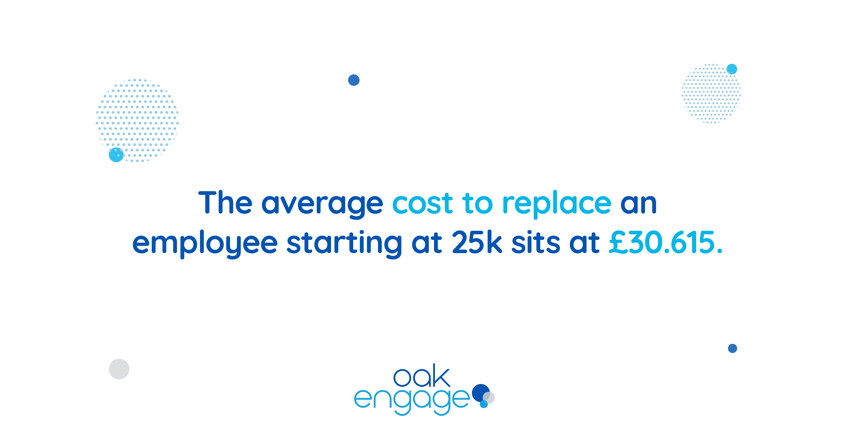
Why Do Employees Leave? [Employee Retention Drivers]
Employees aren’t engaged
Employee engagement is fast becoming a priority for organisations. Having engaged employees can have a huge impact on your retention rates.
Engaged employees are almost 60% less likely to seek out a new job in the next year. Having engaged employees brings increased productivity, profits and participation.
So what can cause employees to become disengaged?
Lack of purpose, no progression with tasks and lack of communication all play a part.
Need some ideas on how you can engage your employees? Check out our blog post that’s full of engagement ideas for your business.
Lack of recognition
By not recognising hard work and appreciating effort employees will feel undervalued. Showing appreciation and that you value employees' work is important. When you incorporate recognition into your retention strategy, your company can expect to lower turnover rate by 31%.
No room for growth
Workers who see no progression are likely to leave and seek opportunities elsewhere. It's important to provide a clear path of progression for your employees. That way they have something to aim for and they can reach their potential.
Outdated technology
Productivity and technology go hand in hand. It’s no secret that the right technology can completely transform your business.
Generations that have grown up with technology are aware of the value that it can bring. It’s essential for businesses to have up to date systems so employees can do their jobs efficiently.
Want to refresh your tech and tools? Take a look at our blog post on Internal Comms tools for 2021 and beyond.
You’re not making your employees wellbeing a priority
Without your employees, you have no workforce. It’s important that you look after their health and wellbeing. Mental health difficulties are the biggest cause of sickness absence in the UK. Poor mental health shockingly costs the UK between £33-42 billion per year.

Investing in your employees wellbeing shows that you value them and place a high level of importance on their health.
Having a proactive approach to wellbeing you'll see increased productivity and less absenteeism. This results in a highly resilient workforce.
Asana has a great wellbeing strategy that focuses on eliminating employee burnout. Their offices are decorated with plants and natural light. Employees can indulge in healthy foods and there are even dedicated nap rooms to rest in. People can also take advantage of daily yoga programmes and free gym memberships.
Here at Oak we also recognise the importance of ‘you time’. We offer some competitive perks like unlimited holidays. Oak also contributes to our employees' choice of fitness programmes, apps and memberships.
Your work policies aren’t flexible enough
Flexible working gives your employees the chance to have a healthy work life balance. Why is this so important? If employees have a poor work life balance it can have a huge impact on mental health, productivity and stress. When employees have a good work life balance they’ll be performing to the best of their ability. They’ll work hard, make less mistakes and be less prone to burnout.
Relationships with co-workers
Work is a big part of our daily lives, taking up a large percentage of our everyday activities. The relationships we have at work can have a huge impact on how we view our jobs. When we have positive relationships at work it has an impact on teamwork. Your business will also benefit from increased morale, productivity and retention rates. When employees have good working relationships they feel connected and positive towards work.
Why Retaining Your Employees is so Important
Legal jobs found that 87% of HR experts consider employee retention as one of the highest priorities in business. Companies who can retain employees experience up to 4x their profits. Not only are profits impacted but the cost of replacing employees can be astounding. Turnover costs of executives being as high as 213%.
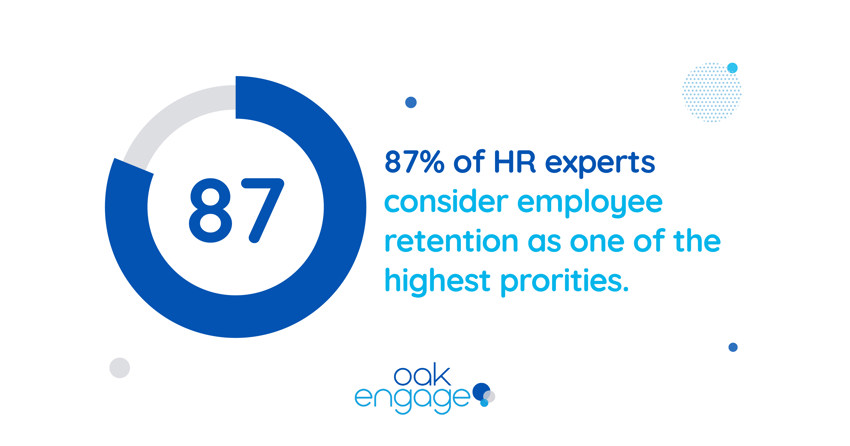
It’s not just costs that should concern businesses. Companies with high turnovers can experience a huge dip in productivity levels. It can be incredibly disruptive for businesses. When experienced employees leave, it may take new employees a while to adapt and fill their shoes. Harvard Business review found that it can take around eight months for a new employee to reach full productivity.
High employee turnover can sometimes create an atmosphere where employees look for excuses to leave. It can almost be a catalyst like a chain reaction, where when one employee leaves others seem to follow.
This can be incredibly detrimental to the morale of other employees who will feel the effects of progress as their teams are disrupted.
Employee retention brings with it a lot of benefits. Focus on retaining employees, keeping them engaged and look after their wellbeing. You’ll reap the rewards.
Increased retention results in greater productivity, profits, increased engagement and employee satisfaction.
How to Measure Employee Retention
To be able to understand employee retention you first need to be aware of your company's own employee retention rates. To calculate employee retention first work out what period of time you want to measure.
Maybe you want to work out your quarterly employee retention rate, or even your yearly employee retention rate. Note down the amount of employees you had at the start of a certain period and at the end of the period, you’ll need these for your calculation.
Employee retention = Total number of employees on the last day of defined period of time / Total number of employees on the first day of defined period of time x 100
Let’s use Oak as an example. If Oak starts with 130 employees and has 120 by the end of the year the calculation would look like this:
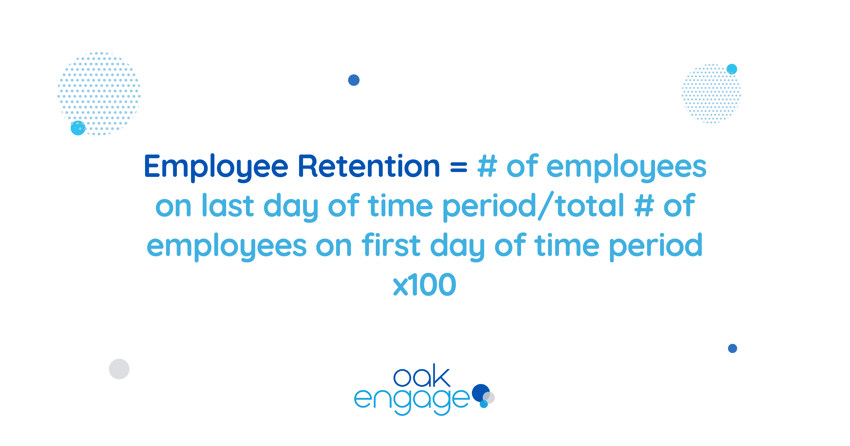
120/130 = 0.92 x 100 = 92
That would make Oaks’ employee retention rate 92%. Pretty good right? You can use this calculation to work out your retention rate for specific departments or teams. By doing this you can work if there are isolated retention issues in a certain area that can be worked on or changed.
Once you have your percentage you can then compare it with the average retention score in your industry or sector.
What is a Good Employee Retention Rate?
Ideally you want your company's retention rate to be around 90%, this is considered a good employee retention rate. The average turnover rate in the UK is 15% however it differs greatly depending on the industry. Turnover rates sit slightly higher in the US at around 20%.
Different industries have different standards for turnover. Hospitality and retail have some of the highest turnover rates, with hospitality turnover rates doubling the UK average. Again the US poses a similar situation, with Food Service, Arts & Entertainment and Retail having the highest turnover rates.
Employee referrals could be the way forward to improve your retention rate as research has shown that referrals are of a higher quality. Referred employees are more likely to stay in their role longer than a non referred hire. JobVite found that 46% of referred hires stick around for at least a year after they’re hired.
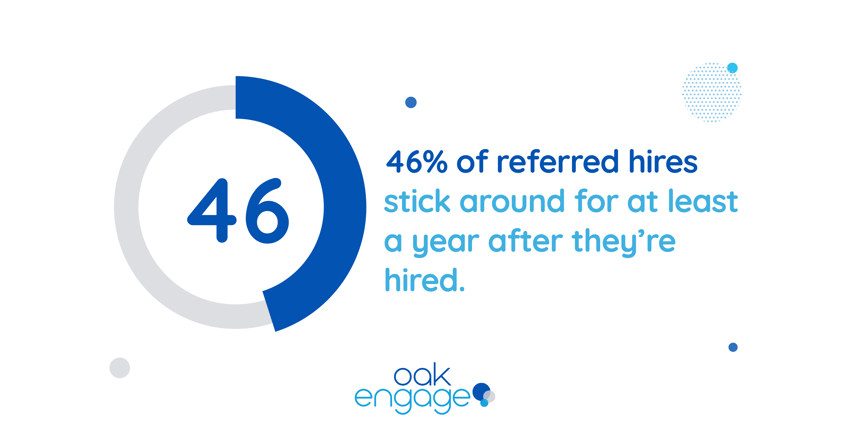
Higher than 33% of people hired through career sites and 22% of people hired through job boards.
Reasons for a Poor Employee Retention Rate
There are a range of things that can impact your employee retention rate,however the most common reasons are:
A lack of work life balance
Having a good work life balance is an important part of having a healthy working environment. The worst thing for your business to have employees suffering from high stress and burnout. Having a good work life balance helps to reduce stress, helps prevent burnout and can have a great impact on productivity and engagement.
Work life balance can mean different things to everyone so why not ask your employees what it means to them? It might mean flexible working hours, the ability to work from home or having a proper health and wellbeing programme in place. This ensures people are using their free time in ways that will impact their mental health positively.
The job doesn’t meet their expectations
In a recent survey, ThriveMap found that 48% of workers left their job because it didn’t align with their job expectations. This can be anything from the job responsibilities to the work environment, hours or even salary and benefits.
Authenticity is the key to making the recruitment process successful. This will ensure you're attracting the right people to your organisation.
Not feeling appreciated and valued
There is a strong link between employee recognition and employee retention. When employees are putting in the hours and effort each day into their tasks, they want to be recognised and appreciated for their efforts.
Imagine how you would feel if no one ever praised your work or thanked you for your time. Achievers even found that lack of recognition and engagement drives 44% of employees to think about switching job roles.
It’s important to champion your teams and ensure their opinions and concerns are listened to. Make sure you’re placing an importance on employee voice.
Read our employee voice ultimate guide so you can encourage employee voice in the workplace.
Lack of growth and progression
Do you have an employee development programme for your employees?
If you do then you’re on the path to attracting great employees who are continuously developing their skills. You’ll also notice an improvement in employee performance and engagement. When employees have a clear goal to work towards they’ll be motivated to work hard to achieve it.
Employee Retention Strategies
So how can you retain your employees when competition is high in the job market right now?
You’ll need a proper employee retention strategy or initiatives in place to ensure your employees are satisfied. Here are some of the best employee retention strategies you can implement:
Competitive salary and benefits: It's vital nowadays to have a competitive salary and benefits package. It sets you apart from the competition and it's great to show your commitment to taking care of employees. When your employees feel that they’re being taken care of it incentivises employees to do their best.
Hiring the right people: Hiring the correct people for your business is essential if you want to avoid high turnover rates. People’s puzzles highlight some useful strategies on how you can hire the right candidate. You want teams with a strong skill set whose values align with the companies.
Employee recognition: Employee recognition is an important part of employee experience. Employees who do not receive recognition are twice as likely to leave their role than those who do. We have a useful guide that breaks down all the different types of employee recognition. You'll learn how to implement them and use the different recognition tools within Oak.
Onboarding: Onboarding employees properly is vital for employee retention. It aligns people with their role, the company values and company culture. If onboarded properly employees can properly contribute to the businesses success. 69% of employees who have a great onboarding experience are likely to stay with the company for at least three years.
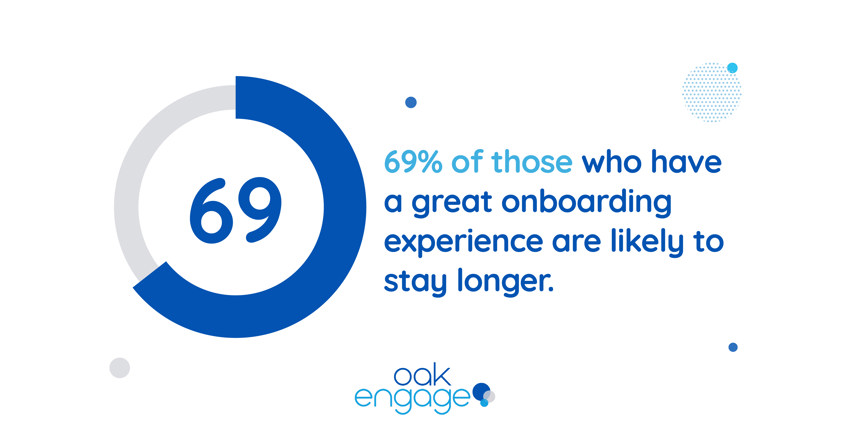
Career growth path: Having a clear growth path for employees gives them a sense of purpose. You'll attract ambitious employees and create an employee centric culture. If you don’t have a clear path of progression for employees they’re likely to look for a job elsewhere. Opportunities for career development and work life balance are amongst the top reasons people search for another job.
Create a positive company culture: Having a good company culture sets the tone for successful business growth. Make sure you’re recognising and rewarding employees. Establish your company values and focus on development. When your employees get on with one another this has a huge impact on your culture. Introduce ways to connect employees so that they can foster good relationships.
Flexible working: Flexible working is so essential for job satisfaction. Your employees will have improved work life balance and increased morale and motivation. The term flexible working covers a range of options. Compressed hours, flexitime, job-shares and remote working are all ways of flexible working. With a range of options available it’s important to find out exactly what would work for you and your workforce.
Focus on employee wellness: Investing in health and wellbeing has an incredible impact. When you think of wellness you might think of fitness initiatives but it goes well beyond that! The CIPD identified seven key areas of employee wellbeing:
- Health
- Good work
- Values and principles
- Social
- Personal growth
- Good lifestyle choices
- Financial wellbeing
Be sure to focus on all of these areas within your wellbeing strategy so you can have a beneficial impact on employees' lives.
As mentioned previously, placing a high value on employee voice is so important for your employees. A key indicator of success and having happy employees is your businesses ability to make employees feel heard. Not having a voice in the workplace can lead to disengagement and poor company culture.
How an Intranet Can Help with Employee Retention
Intranets are a key drive of employee retention. Millennials will make up 75% of the global workforce by 2025. Zapier has found that 16% of gen z and millennial employees have quit their job because of poor tech.
But how can intranets help with employee retention? Here’s how:
Company Culture
Building a better company culture doesn't mean providing employee perks. It means recruiting workers who fit your organisation’s vision and values.
By trusting your employees, you promote better engagement. Responsibility pushes them into situations where they go the extra mile. It results in a better work culture and improves employee retention.
Gallup found that employees who are more engaged and productive at work are 59% less likely to look for a different job in the next 12 months. An intranet can act as a platform for building a happy workplace culture. Having tools that support employees through their professional journey impacts employee experience.
Intranets allow you to source feedback and turn it into an action. Surveys can be distributed to employees, with responses that are measured in real-time.
Engagement and pulse surveys are key in creating an employee retention strategy. Leaders can act on employee feedback quickly. This brings solutions to the workforce to help them be more engaged and productive in their role.
Employee Recognition
Recognising and appreciating your workforce is critical to employee retention. Unfortunately, some companies don't realise how important this is. They think recognition equals a financial incentive - this is not the case.
Over 91% of HR professionals believe that recognition and reward is key to retaining employees. Achievers statistics proves this as they found that lack of recognition and engagement causes 44% of employees to change their jobs. Do you have any methods of appreciating and celebrating your employees' efforts?
When your employees feel noticed and appreciated, they’re inclined to work hard and feel motivated. Oak has an easy to use recognition system which can be used by all users to highlight achievements. This can be anything from great work and acts of kindness happening within the company. This has a significant influence on productivity, motivation and satisfaction between employees.
Recognition programs are no longer an idea to toy with, they’re vital for employee engagement. And it can all be done efficiently within your own intranet.
With a huge array of customization features a modern intranet has some of the most useful tools you need. This is essential when implementing employee recognition initiatives to improve employee retention.
Here are some ways to use your digital workplace to spotlight worthy employees:
- Give shout-outs on social media.
- Spotlight employees on the blog.
- Post appreciations on your intranet timeline.
- Create group messages within your social intranet, highlighting an employee's achievements.
Communication & Collaboration
If you don't communicate and collaborate with employees, you'll be prone to problems. Utilising communication channels is so important in employee retention strategy.
The State of Employee Communication and Engagement Report found ineffective communication impacts retention. 52% of senior level executives found misalignment causes negative financial and retention implications. A further 56% of communicators struggle to keep employees engaged with important information.
If your employees aren't up to date with company information this causes misalignment.
User-friendly intranets are great for communication and increasing employee engagement. It allows employees to access all the information they need in a format that best suits their needs.
Communication and collaboration features of an intranet
Oak’s search functionality enables users to locate all content, past or present. This means no more wasting valuable time searching for important documents. Search helps employees to find whatever you need instantly.
Time saved means more time to focus on important tasks and improves collaboration!
Oak messenger is integrated within the intranet. It's designed to improve communication and workplace productivity. Users can send instant messages to one specific person or a whole group. Perfect for department communication, remote workers and general social interaction between employees.
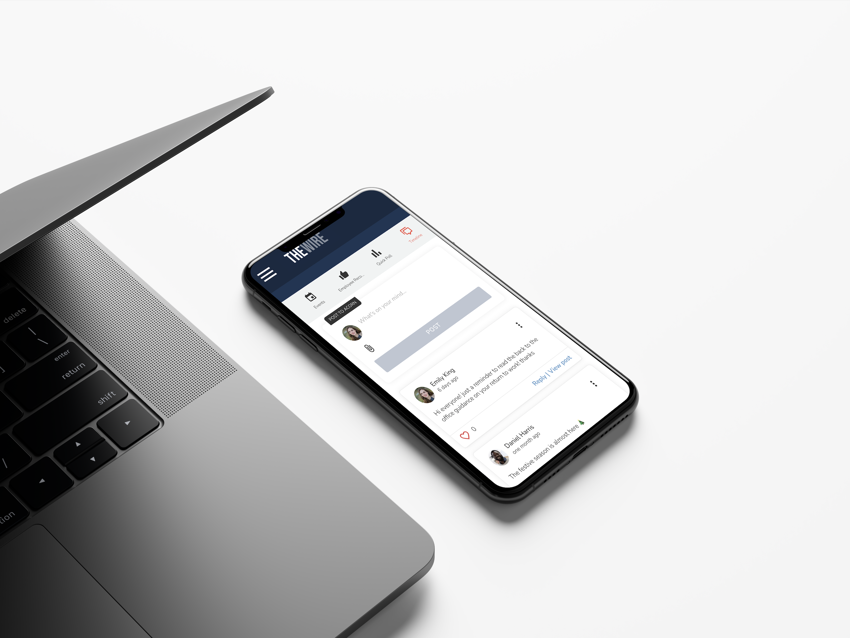
Job Satisfaction
For management, it can be challenging to find out how happy your employees are at work. What tools or methods do you use to find out the actual thoughts and feelings of workers? Many businesses struggle to empathise with employees and this can cause retention issues.
Employees who are highly engaged are 87% less likely to leave an employer. Furthermore, employees who are satisfied in their job experience 59% less employee turnover.
Build feedback opportunities for two-way communication. Solving problems whilst also making employees feel heard can have a positive impact on loyalty. Give your employees the opportunity to provide feedback and consider their suggestions.
Oak intranet features to improve job satisfaction
Pulse Surveys are used to gather real, actionable insights. Businesses can use feedback to improve employee engagement, productivity and collaboration. Oak surveys provide a basis for gaining valuable data from employees, all within the company intranet.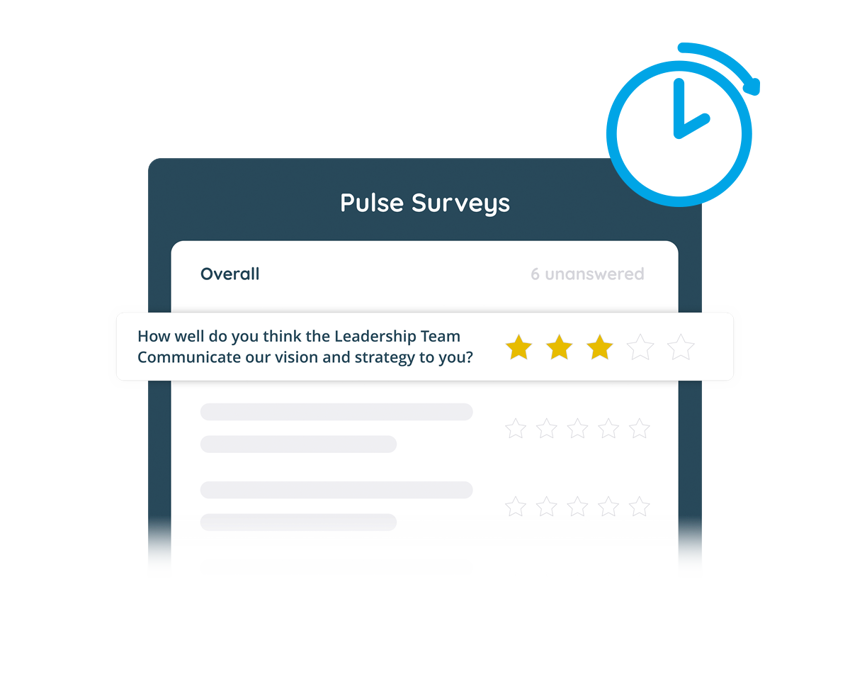
Oak also provides polls as a feature. Companies no longer have to gather information by email, but can simply start a poll. It may be used to get an understanding of what your people want. Or you can create conversations or leverage a poll to generate content. After all, people are more likely to invest in content that they helped create.
By using your intranet to communicate with your employees properly and create the right working environment.
Want to know more about Oak?
If you would like to find out how Oak could help you with retaining your employees feel free to get in touch. Or, why not check out our blog on how you can utilise your company intranet to its full potential.
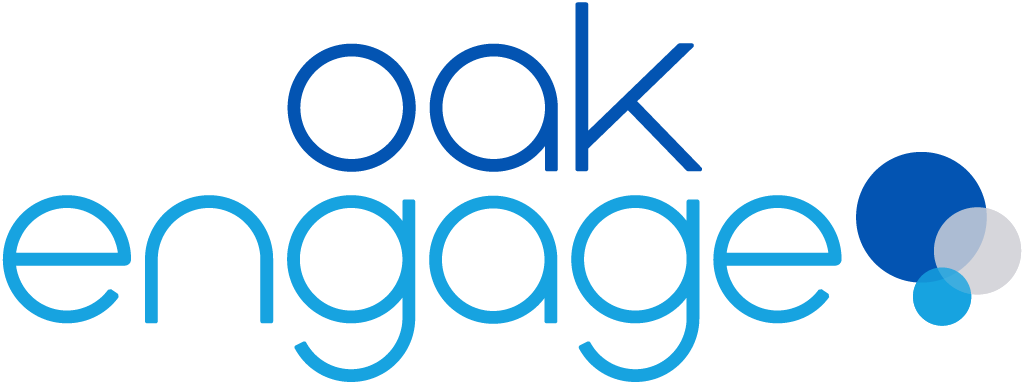

![Employee Retention Strategies [How To Keep Your Staff]](/media/ohznpw03/employee-retention-min.jpg?width=50)
